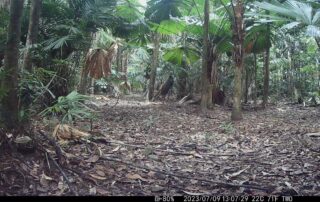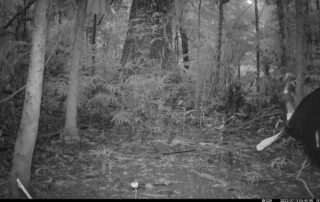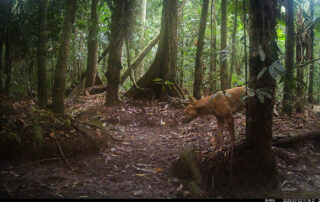Camera Traps – July 2023 accrued 130-cassowary sightings, 68-dingoes and 305-feral pigs. Against the cumulative monthly average, cassowary numbers rose by 17%, whilst dingo-sightings fell by 39% and feral-pig numbers grew by 128%. Against July 2022, cassowaries were 71% higher, dingoes soared by 871% as did feral-pigs by 426%.
Image highlights from Camera Traps – July 2023
Draft National Recovery Plan for the Southern Cassowary (Casuarius casuarius johnsonii) has been released for public comment – period closes 6 September 2023.
Lau-Lau’s reaction to my conveying of the report …
The Southern Cassowary (Casuarius casuarius johnsonii) is recognised and valued for its unrivalled ecological importance and irreplaceability to biodiversity richness, security and productivity. A successful recovery plan must ensure Australia’s Cassowary populations are healthy and secure across their full potential range and that each population coexists with informed, empowered and adequately resourced communities who discharge custodial excellence through ecosystem management expertise.
Heavily pregnant sow within the unintended legislative protection of World Heritage …
As the Cassowary has finite habitat, the main variable that can increase cassowary carrying capacity is removal of competing invasive species – and feral pigs in particular. This estimated 30,000 feral-pigs within Queensland’s Wet Tropical rainforests (where there should be none) represents a bulk of energy and resource consumption that is unavailable to Southern Cassowaries. Feral-pigs displace male cassowaries from their nests and devour their eggs. Feral-pigs predate upon juvenile cassowaries. Feral-pigs also attract recreational pig-hunters who invariably bring dogs, typically large aggressive breeds and usually four at a time, and they are not always well managed. The key threatening process, having been verified and federally declared, enjoys an effective sanctuary within the vast expanse of Protected Area management.
Eradicating feral-pigs from the Wet Tropics is the main thing can substantially improve the carrying capacity of Southern Cassowaries. However, such an objective cannot be met if nothing is done about the estimated 24-million feral-pigs running rampant across the continent (with an estimated 50% in the Cassowary-state of Queensland). This Recovery Plan should encourage Australia, through the Commonwealth Parliament if necessary, to bind the country under law to the complete eradication of feral-pigs by a set-date, say 2050, and then provide the resources to see it to fruition. Anything less is a death-sentence to the Southern Cassowary and a precursor the ecological collapse of the Wet Tropics.
Healthy male dingo (feral-pig predator) …
Australia’s native Canid – the Dingo is held in undeniable contempt, when it is ‘protected’ as Native Fauna upon declared Protected Areas, but instantly condemned to death as it transgresses across change of tenure to become a legislatively declared ‘Wild Dog’ on the ~90% of the State that is not declared as ‘Protected Area’. Indeed, the one species of meso-predator that not only kills feral-pigs through direct predation, but more significantly, displaces feral-pigs from areas they are more likely to suffer from predatory danger, delivers direct advantages to Cassowaries. Therefore, a proactive Cassowary Recovery Plan should restore a Protected Species status to Dingoes across all tenures, for their vital importance in feral-pig predation and Cassowary recovery.
Prudy on the prowl …
Taiga & Tex … (Taiga has already mated with Prudy, but is conflicted by his paternal attachment to Tex)
Daintree Rainforest Foundation Ltd has been registered by the Australian Charities and Not-for-profits Commission and successfully entered onto the Register of Environmental Organisations. Donations made to the Daintree Rainforest Fund support the Daintree Rainforest community custodianship and are eligible for a tax deduction under the Income Tax Assessment Act 1997.





















